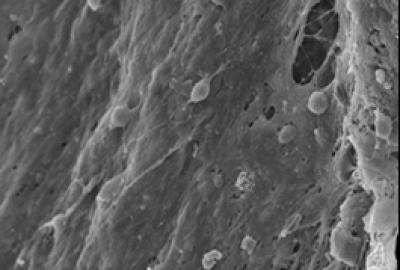Using a novel scaffold to repair spinal cord injury

Through transmission electron microscope, neural stem cells attached to the double-layer collagen membrane with unequal pore sizes and there was no structural change in the double-layer collagen membrane. Credit: Neural Regeneration Research
The loose layer was infiltrated with a large amount of neural stem cells before it was transplanted in vivo. Thus a plenty of neural stem cells can be provided at the target spinal cord site.
The loose layer was adhered to the injured side and the compact layer was placed against the lateral side. The compact layer has very small holes, so it can prevent ingrowth of adjacent scar tissue.
It can also prevent the loss of inner neural stem cells and the neural growth factors secreted by the differentiated neural stem cells.
Thus a good microenvironment forms to help spinal cord injury repair. Yuan Ning and colleagues found that transplantation of neural stem cells in a double-layer collagen membrane with unequal pore sizes is an effective therapeutic strategy to repair an injured spinal cord in rats.
Related results were published in Neural Regeneration Research (Vol. 9, No. 10, 2014).
Article: ” Neural stem cell transplantation in a double-layer collagen membrane with unequal pore sizes for spinal cord injury repair,” by Ning Yuan1, Wei Tian1, Lei Sun2, Runying Yuan2, Jianfeng Tao2, Dafu Chen2 (1 Department of Spine, Beijing Jishuitan Hospital, Beijing, China; 2 Beijing Institute of Orthopedics and Traumatology, Beijing, China) Yuan N, Tian W, Sun L, Yuan RY, Tao JF, Chen DF. Neural stem cell transplantation in a double-layer collagen membrane with unequal pore sizes for spinal cord injury repair. Neural Regen Res. 2014;9(10):1014-1019.
Contact: Meng Zhao
eic@nrren.org
86-138-049-98773
Neural Regeneration Research
http://www.nrronline.org/
Media Contact
All latest news from the category: Life Sciences and Chemistry
Articles and reports from the Life Sciences and chemistry area deal with applied and basic research into modern biology, chemistry and human medicine.
Valuable information can be found on a range of life sciences fields including bacteriology, biochemistry, bionics, bioinformatics, biophysics, biotechnology, genetics, geobotany, human biology, marine biology, microbiology, molecular biology, cellular biology, zoology, bioinorganic chemistry, microchemistry and environmental chemistry.
Newest articles

A universal framework for spatial biology
SpatialData is a freely accessible tool to unify and integrate data from different omics technologies accounting for spatial information, which can provide holistic insights into health and disease. Biological processes…

How complex biological processes arise
A $20 million grant from the U.S. National Science Foundation (NSF) will support the establishment and operation of the National Synthesis Center for Emergence in the Molecular and Cellular Sciences (NCEMS) at…

Airborne single-photon lidar system achieves high-resolution 3D imaging
Compact, low-power system opens doors for photon-efficient drone and satellite-based environmental monitoring and mapping. Researchers have developed a compact and lightweight single-photon airborne lidar system that can acquire high-resolution 3D…





















